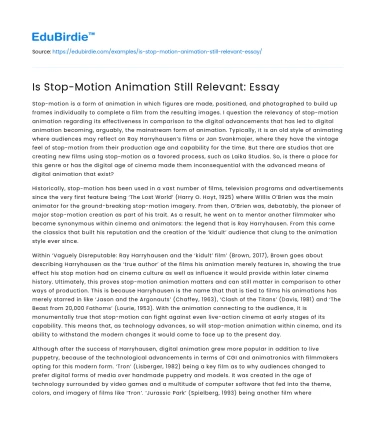Stop-motion is a form of animation in which figures are made, positioned, and photographed to build up frames individually to complete a film from the resulting images. I question the relevancy of stop-motion animation regarding its effectiveness in comparison to the digital advancements that has led to digital animation becoming, arguably, the mainstream form of animation. Typically, it is an old style of animating where audiences may reflect on Ray Harryhausen’s films or Jan Svankmajer, where they have the vintage feel of stop-motion from their production age and capability for the time. But there are studios that are creating new films using stop-motion as a favored process, such as Laika Studios. So, is there a place for this genre or has the digital age of cinema made them inconsequential with the advanced means of digital animation that exist?
Historically, stop-motion has been used in a vast number of films, television programs and advertisements since the very first feature being ‘The Lost World’ (Harry O. Hoyt, 1925) where Willis O’Brien was the main animator for the ground-breaking stop-motion imagery. From then, O’Brien was, debatably, the pioneer of major stop-motion creation as part of his trait. As a result, he went on to mentor another filmmaker who became synonymous within cinema and animators: the legend that is Ray Harryhausen. From this came the classics that built his reputation and the creation of the ‘kidult’ audience that clung to the animation style ever since.
Save your time!
We can take care of your essay
- Proper editing and formatting
- Free revision, title page, and bibliography
- Flexible prices and money-back guarantee
Within ‘Vaguely Disreputable: Ray Harryhausen and the ‘kidult’ film’ (Brown, 2017), Brown goes about describing Harryhausen as the ‘true author’ of the films his animation merely features in, showing the true effect his stop motion had on cinema culture as well as influence it would provide within later cinema history. Ultimately, this proves stop-motion animation matters and can still matter in comparison to other ways of production. This is because Harryhausen is the name that that is tied to films his animations has merely starred in like ‘Jason and the Argonauts’ (Chaffey, 1963), ‘Clash of the Titans’ (Davis, 1981) and ‘The Beast from 20,000 Fathoms’ (Lourie, 1953). With the animation connecting to the audience, it is monumentally true that stop-motion can fight against even live-action cinema at early stages of its capability. This means that, as technology advances, so will stop-motion animation within cinema, and its ability to withstand the modern changes it would come to face up to the present day.
Although after the success of Harryhausen, digital animation grew more popular in addition to live puppetry, because of the technological advancements in terms of CGI and animatronics with filmmakers opting for this modern form. ‘Tron’ (Lisberger, 1982) being a key film as to why audiences changed to prefer digital forms of media over handmade puppetry and models. It was created in the age of technology surrounded by video games and a multitude of computer software that fed into the theme, colors, and imagery of films like ‘Tron’. ‘Jurassic Park’ (Spielberg, 1993) being another film where both CGI and animatronics were opted for more realism and smoothness to be able to be live movements and sizing. This was the modern creature animation comparison to that of Harryhausen’s and O’Brien’s works. Being an impossibility to recreate or develop via stop-motion animation, the form was curbed in relation to what it had been because of audience opinion shifting to the up-to-date films compared to what stop-motion was.






 Stuck on your essay?
Stuck on your essay?

